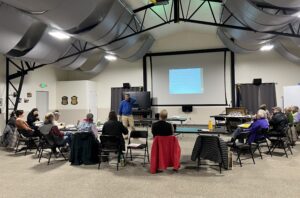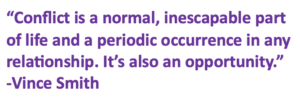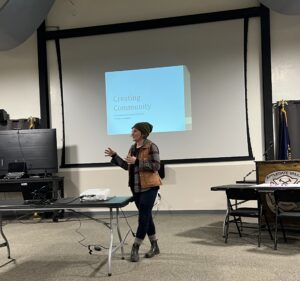Collaborative efforts in the Applegate Valley are on the rise. Vince Smith, from Southern Oregon University, shares tips on how to work together.

Instructor Vince Smith cautions groups against rushing to “psuedo-solutions’ in order to avoid conflict.
By Christina Ammon
I had an ‘ah-ha’ moment at the Group Facilitation and Decision-Making Training offered Feb 23rd at the Applegate Fire Stations. It came when the instructor, Vince Smith from Southern Oregon University asked us to consider the notion that our adversaries might actually be our collaborators.
Huh?
The meeting, sponsored by A Greater Applegate (AGA), is the second in a series offered for free to the region. The classes focus on community building, leadership, and action planning.
To illustrate his point, Smith asked the group to think of challenging regional issues. The group threw out some general themes: Dealing with code enforcement; trying to find sale outlets for local products; the controversies around cannabis farms.
 Smith cautioned against placing blame on these perceived obstacles—which only galvanizes conflict. “The barrier often has your solution,’ said Smith. He advised that it’s best to ”rightfully place control where it belongs and not the blame.” Instead, it’s better to ask: What’s the common interest? How can they be collaborators? This mind-set shift is more likely to produce solutions.
Smith cautioned against placing blame on these perceived obstacles—which only galvanizes conflict. “The barrier often has your solution,’ said Smith. He advised that it’s best to ”rightfully place control where it belongs and not the blame.” Instead, it’s better to ask: What’s the common interest? How can they be collaborators? This mind-set shift is more likely to produce solutions.
Of course, this is easier said than done, so it’s a good thing the rest of the workshop was spent on communication techniques that unite people under common values.
Increased Community Coordination in the Applegate.
The last couple of years have brought an increase in community collaboration as the community-designed Applegate Valley Vision Plan is put into action. Various working groups have formed to carry out the goals outlined in the Vision—like networking local farms, transportation, and forest and fire protection. In implementing these efforts, communication skills are more important than ever.
“Our goal is to make connections between people who are doing good things,” said AGA’s co-Executive Director, Megan Fehrman. Local leaders like Elise Higley from Oshala Farm, Frances Oyungfrom Rogue Riverkeeper, Alice Jones from Visit Grants Pass, and Jim Reiland from Many Hands Builders were in attendance.
“We want to encourage community-led action since AGA, as a small nonprofit, can’t do it all,” Fehrman said.
Smith had started the meeting asking the group what they loved about the Applegate. Answers tumbled out: The plant diversity, the views, the people. Local farmer Amy Quatman mentioned falling in love with the Williams General Store, which won her over with its local product offerings and bulk bins. Smith pointed out that finding common ground was the starting point to solving problems. In this case: Everyone loved the sense of community and natural beauty of the Valley.
Conflict is Inevitable.
Another core message of the meeting was that conflict is a “normal, inescapable part of life and a periodic occurrence in any relationship.” Smith also pointed out that it’s an opportunity.

“We want to encourage community-led action since AGA, as a small nonprofit, can’t do it all.” Co-Executive Director, Megan Fehrman
To avoid conflict, people often rush to what he called “pseudo-solutions”– which are superficial band-aids that only lead to more conflict later. It’s essential, he pointed out, for groups to develop a tolerance to what he called the ‘groan zone’ –the portion of the problem-solving process that can feel chaotic, non-linear, frustrating, and disorderly. This uncomfortable stage in the process is often the prelude to creativity and solutions.
Smith put forth a few pointers for group leaders: To be on alert for group members that might be self-censoring because they feel marginalized. He also had tips on how to handle members with stubborn viewpoints and win-lose mentalities.
Paraphrasing, drawing people out, and allowing silence were all effective techniques.
Smith said a hallmark of healthy conflict is when the group is focusing on the issue, not the people they disagree with. When working with a group, it’s key to make sure everyone is fully heard. Everyone should have a pathway to “own” the solution, even if it’s not their ideal.
Coming Closer Together
Allison Cleveland facilitates groups for marginalized communities through the Oregon Anti-Violence Project. She relocated back to the area recently. “I came here to try and take the temperature of the area I’m in and find out what works here. I’ll be using some of these skills,” she explained.
“I’m interested in living in community better and being a more active member,” said Amy Quatman. “I’m often the person that wants to give up in the groan zone! I feel reassured that conflict is a ‘known’ thing.”
Fehrman is pleased that the workshops are providing the tools that the working groups will need to carry out the Vision: “We want to make sure people are coming closer together—instead of further apart.”
The last workshop in the series is titled “30-60-90 Day Action Planning” and it will be held on Thursday, March 2 from 5:00-7:00 pm.

